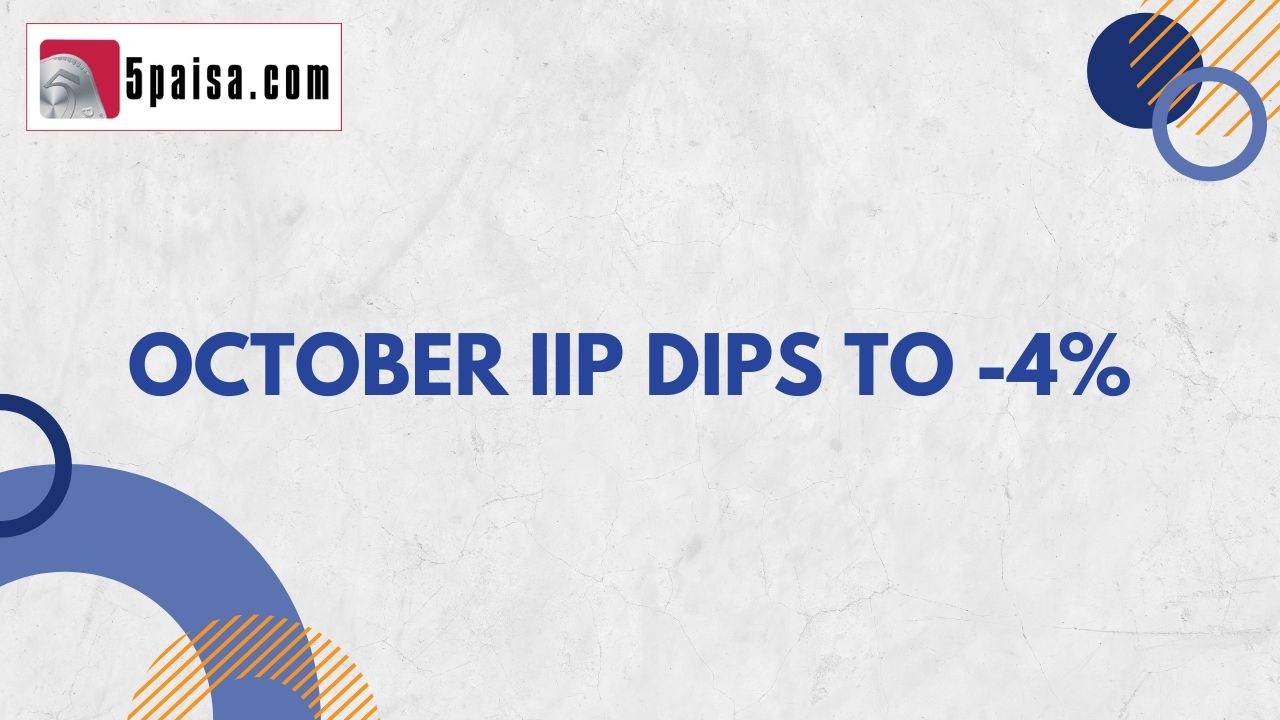SEBI Poised for Significant Action Following Warnings on SME IPOs
October IIP dips to - 4.0% due to stress on manufacturing

Last Updated: 13th December 2022 - 05:02 pm
On 12ths December, the MOSPI announced the IIP figure for October 2022 (IIP is announced with 1-month lag), along with the consumer inflation for November 2022. The IIP was disappointing, to say the least as it contracted -4.0% for October on a yoy basis. In the last 3 months, this is the second occasion when the IIP has been in negative, after reporting -0.68% contraction in August 2022. Till July 2022, there 17 consecutive months of positive IIP, but in the last 3 months there have been 2 months of negative IIP. Clearly, it is the global headwinds and the domestic constraints that are hitting IIP growth significantly. Here is a quick time series flow of IIP growth over the last 13 months on a yoy basis.
|
Month |
IIP growth (%) |
|
Oct-21 |
4.17% |
|
Nov-21 |
1.03% |
|
Dec-21 |
1.02% |
|
Jan-22 |
1.98% |
|
Feb-22 |
1.15% |
|
Mar-22 |
2.20% |
|
Apr-22 |
6.66% |
|
May-22 |
19.72% |
|
Jun-22 |
12.62% |
|
Jul-22 |
2.21% |
|
Aug-22 |
-0.68% |
|
Sep-22 |
3.47% |
|
Oct-22 |
-4.00% |
Data Source: MOSPI
The good news in the IIP numbers is that revisions have been on the positive side. For instance, the first revision for September 2022 IIP growth led to the IIP being upgraded by 38 bps from 3.09% to 3.47%. That is reason to be optimistic that the contraction may be lower than estimated in October 2022. However, the bad news is that, October IIP has contracted despite a stable base. For example, IIP growth in October 2021 was 4.17% and 4.35% in September 2021. In the current year, IIP grew 3.47% in September 2022 but contracted by -4.0% in October 2022. The villain of the piece was manufacturing growth, which bore the brunt of supply chain constraints, weak exports and high cost of funds.
What we read from the IIP data for October 2022
The IIP contraction has been a function of weak export growth, tepid global demand, consumer caution and high cost of funds. Here are the takeaways.
-
If you look at the 3 major components of IIP for October 2022; then Mining growth stood at 2.46%, manufacturing contracted by -5.65% while Electricity grew 1.20%. Quite obviously, the overall IIP figure gravitated towards manufacturing due to its inordinately high weight of 77.63% weightage in the IIP basket.
-
However, the manufacturing problem has been pronounced only in the last 2-3 months. For instance, if you consider the 7 months of FY23 till IIP data is available; then mining is up 4.0%, manufacturing is up 5.0% and electricity up 9.4%. The brunt of the pressure on manufacturing has only happened in the last couple of months.
-
Even in a tepid month for manufacturing, there were some sectors that did well. For instance, printing products, media, motor vehicles, furniture and metal products did perform well. However, contraction was seen in a number of products in the IIP basket. For instance, Apparel (-37.1%), Electrical Equipment (-33.2%), Leather Products (-24.3%), Textiles (-18.6%), wood products (-12.7%) and paper products (-8.9%) were some of the key IIP depressants. The common thread among these depressants is that most of them are export dependent sectors, which are hit hardest by central bank hawkishness, weak export demand and consumer hesitation to spend.
-
The real problem for IIP is not supply constraints but demand insufficiency. That is evident if you look at the use-based IIP break-up for October 2022? The real pressure on use-based IIP came from 2 specific demand segments. Consumer durables demand contracted by -15.3% while the demand for consumer non-durables contracted -13.4%. Consumption (or the willingness to spend) has been the biggest casualty in the process.
-
The yoy IIP that we have been talking about is good to give a trend, but it fails to capture the short term momentum. For October, let us juxtapose the YOY IIP movement with the MOM IIP movement. MOM growth is also high frequency (HF) growth.
|
Weight |
Segment |
IIP Growth Over Oct-21 |
IIP Growth (HF) Over Sep-22 |
|
0.1437 |
Mining |
+2.46% |
+12.5% |
|
0.7764 |
Manufacturing |
-5.65% |
-4.53% |
|
0.0799 |
Electricity |
+1.20% |
-9.66% |
|
1.0000 |
Overall IIP |
-4.00% |
-3.28% |
Data Source: MOSPI
That is a double whammy for IIP in October. The long term trend depicted by YOY growth has contracted by -4.00%, but even the high frequency MOM IIP has contracted by -3.28%. In high frequency terms, both manufacturing and electricity are under pressure. This highlights the impact of short term global and domestic headwinds.
Will IIP contraction force the RBI to go easy?
It is said that a few swallows do not a summer make. The RBI may not be in a position to take a decision based on 1 month IIP contraction, but the RBI will have other things in mind. India had reported 6.3% GDP growth in the second quarter giving hopes of full year growth in GDP of around 7%. However, that is unlikely to happen unless the cost of funds come down sharply and export demand gets a boost. A quick glance at the quarterly results is enough to tell you that the pressure of interest costs is quite substantial in Q2, which is evident from the weakening of the interest coverage ratio. This is on top of the sharp spike in the cost of inputs, that are putting pressure on the operating profits of companies.
Like the Fed, even the RBI has front-loaded rate hikes, pegging the rates already at 110 bps above the pre-COVID rate. It must not be missed that the entire India narrative today is predicated on 7% GDP growth and outdoing China by 400 bps on GDP growth. For now, the RBI and the government has to focus on what it can control. Global factors like Ukraine, oil and US demand is not in the control of the RBI. However, domestic liquidity and domestic rates are under the RBI control. The IIP data has indicated that it is time for the RBI to heed these signals and turn its stance less anti-inflation and more pro-growth.
Trending on 5paisa
Discover more of what matters to you.
Indian Market Related Articles
Disclaimer: Investment in securities market are subject to market risks, read all the related documents carefully before investing. For detailed disclaimer please Click here.
 Tanushree Jaiswal
Tanushree Jaiswal




